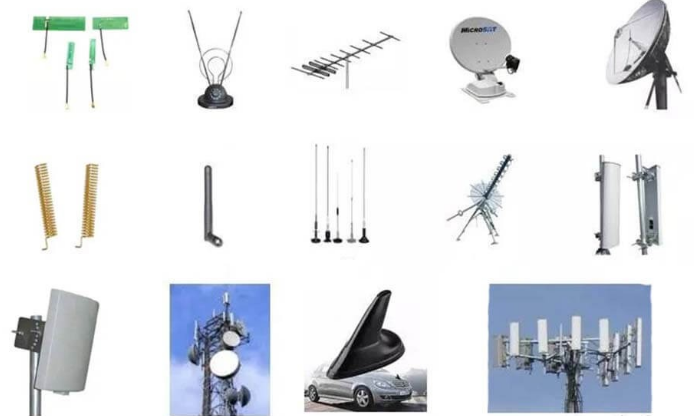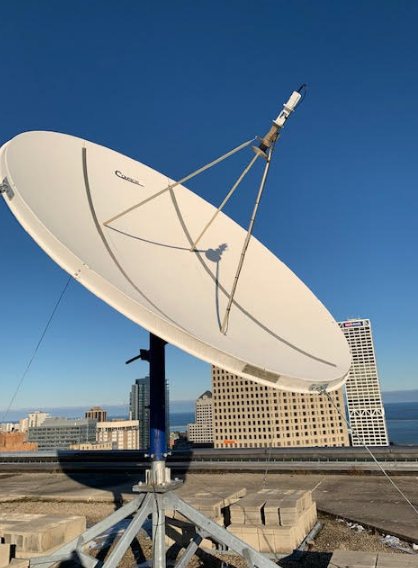Satellite communication utilizes various antennas:1. Parabolic dishes focus signals over long distances; 2.horn antennas direct waves effectively; 3.phased arrays offer dynamic beam steering; 4.helical antennas support circular polarization; 5.patch antennas are compact and fit into small devices.
Parabolic Dish Antennas
The parabolic dish antennas are ubiquitous in satellite communications, primarily because they enable focusing a tight beam of radio waves aimed at geostationary satellites. The configuration, optimized for focusing, minimizes the fraction of the power transmitted lost in the atmosphere, increasing the effective capacity and signal quality over vast distances. The design of a feed placed in or near the focus of the dish usually travels a distance that is nearly equivalent to all other points to the feed at the dish surface, minimizes the energy loss. The cost of a standard parabolic dish antenna is in the range of 45 cm to 3 meters, depending on the practical needs and convenience.
For example, companies that provide home direct-to-home services, where high frequency both lessens the overall size required than a higher frequency and increases the signal strength, should suffice with a smaller one, about 45 to 60 cm. In contrast, satellite internet services may require a 1.2m dish to pick up weaker signals over long ranges. The cost of a dish, assuming a quality silicon chip and solid LNB, may vary from $200 to $400 for a 1.2m size, varies based on the size of the dish and the quality of the material. In addition, professional installations placed for high definition broadcasting or heavy broadband charges may reach an hour.
The costs are in the thousands of dollars, with dishes coated with high-durability materials, such as high quality steel or high grade aluminum, further increasing the total cost. The use of a standard parabolic dish antenna reduces costs somewhat, by the ability to conduct the installation and its maintenance. Since with proper installation and care they can last for 10 to 15 years minimum irrespective of weather and pollution, and the long-term communication projects essential in heavily remote areas, this benefit cannot be underestimated.

Horn Antennas
In situations that demand precision and reliability, no antennas are more widespread and useful for satellite communications than horn antennas. These antennas function by using a flared waveguide structure in which a radio wave generates along the narrow dimension of the waveguide. The structure gradually expands, creating a horn. This solution is instrumental, as this type of horn structure allows the radio wave signal to be directed tightly along its axis, and the antenna’s bandwidth is increased. This characteristic simplifies the process of feeding radio waves to larger parabolic dish antennas. Alternatively, when communicating with satellites of small size, the high-frequency signal can be sent directly to the satellite with the same type of horn antenna. The use of such horn antennas in space communications, such as those used by NASA for future planetary missions, are an example of a horn antenna’s everyday use. Low signal strengths are expected when the antennas are considered. Furthermore, the long-distance transmission requires the antennas to generate a highly directional pattern. A horn antenna is suited to handle both situations. The horn antenna pays for itself in the long run, as a power is maximized toward the satellite, which reduces its signal gradient loss over distance.
The horn antenna is cheaper compared to other high-gain antennas such as large parabolic dish antennas. It has fewer construction requirements in terms of space, involving a simple short-range solution. In amateur satellite tracking, setting up a simple horn antenna costs around $300 to $500. The expenses of this model of a horn antenna range from approximately $10 per feet, combined with cheap adapter wrings. The horn antennas become relevant to more technologically-inclined educational institutions and top-hobbyist. The durability of horn antennas is directly related to their simple design. They are likely to serve for more than 15 years, as they feature simple and sturdy structures. The antennas have no moving parts and are made from a durable material such as aluminum or copper, which corrosion is not likely to damage.
Phased Array Antennas
Phased array antennas are a major improvement in the field of satellite communication and a new generation of antennas with capabilities that traditional mechanical antennas do not have. Phased array antennas consist of an array of small individual antennas, or elements, each of which can be controlled electronically. The changes in phase of the individual elements of the antenna allow the main lobe to be directed at a controlled angle. Since the beam pattern can be formed by electronic steering, the antenna can be redirected at any time, without the need to physically move it. As the position of a satellite in the sky changes, the phased array antenna’s focus can follow the object and direct the signal to it. The benefits of such a design is that antennas can track the satellite in real-time, without delay, due to the instantaneous speed of changing the beam direction.
A prime example of such antennas’ implementation is in the field of the internet, where companies such as SpaceX are developing new systems to provide broadband globally. In these applications, phased array antennas enable keeping the near-constant connection to the low-earth orbit (LEO) satellites, ensuring that the beam direction follows the satellite as it orbits Earth. The use of such an approach eliminates mechanical parts present in classical antenna design used to physically steer the beam of the antenna and minimizes the need for maintenance. The decreased number of components in the design and the reduced need for maintenance significantly decreases the cost of such antenna systems.
Overall, phased array antennas are devices that fill a niche where mobility and speed are of the utmost importance. They provide both military radar and civilian application systems that require fast beam steering an easily directed and quickly responding units that can effectively track fast-moving objects. The robust design of these antennas and their ability to track objects moving at high speeds in merely milliseconds creates a set of advantages against traditional antennas that in situations define detection or failure. For instance, a radar system using traditional antennas could not track these fast-moving aircraft and would not be working by the time it reached the seventh tracked due to the low speed of the mechanical movement of the antennas.

Helical Antennas
One of the most noticeable and peculiar classes of antennas is the helical variety, which reflects the unusual shape of the structure. Helical antennas are particularly suitable for satellite communication, with the round shape allowing them to obtain circular polarization. The capability to work with signals of both rotational directions — clockwise and counterclockwise — is implied by the technical abilities of such antennas. As satellites in low Earth orbit fly overhead, they may have various placements and poses in relation to Earth, necessitating the use of antennas that have the ability to switch their direction of rotation.
The most common use of these antennas is by amateur radio enthusiasts, who use them for communication with satellites of various types. Satellite radio communication takes place over the VHF and UHF frequencies, which amateur radio frequently uses. The cost of a single helical antenna varies between $100 and $300, depending on the quantity of winds and the antenna’s gain. Thus, this antenna type is the most inexpensive for such a sophisticated class, as it is possible to speak to and hear geostationary satellites on such antennas.
In addition, helical antennas, thanks to their design, are durable and suitable for a variety of environmental conditions. As a general rule, these antennas are made of simple metal wire that remains in working order and retains its shape in virtually any environmental conditions. The life expectancy of such antennas is greater than ten years. It only requires a clean and properly dissected storage space without the need for special conditions.
Furthermore, the polarization of many satellite transmissions may be matched by the helical antennas, reducing signal loss. This is advantageous in situations such as satellite TV broadcasting, in which potential consumers would prefer not to spend large sums on signal detection.
Patch Antennas
Patch antennas, or microstrip antennas, have long been popular for their compactness and versatility in satellite communications, particularly on the satellite itself or in devices that require a small form factor. They consist of a flat rectangular sheet, referred to as a “patch,” of a conductive material, which is mounted over a larger sheet of metal called the “ground plane”. While the design is simple and practical, enabling a variety of applications, such as the mounting patch antennas onto the ground portion of the spacecraft, using the satellite’s support structure for external antennas, and even integrating the antenna in portable devices, such as GPSs or smartphones, the patch antenna can be found strategically placed throughout the satellite design.
The main benefit of the patch antennas is that they are thin and have a low profile; this makes them easily processable to the structural surfaces of spacecraft and portable satellite communication devices, such as a phone or a handheld satellite phone. Indeed, many of the modern smartphones or GPS units commercially available today are equipped with the patch antennas. These devices can be only a few millimeters long, which makes them a perfect element of such slim design. They are also efficient though they are fairly small; with the use of modern materials, they can be made to be similar to larger traditional antennas.
Patch antennas are so widely used because they are cheap to make; because of their simplicity of design and commonality of the materials used, such as copper or another conductive material on a dielectric substrate, they cost around five to fifty dollars, depending on the frequency band used. Thus, the patch antennas are commonly used in household electronic devices, such as smartphones, as well as large networks, such as satellite constellations, where almost a thousand antennas are needed, maybe more. They are also in frequent use in satellite communications, because of the ability to operate on a wide range of frequencies used for mobile communications, broadcasting and other purposes. The lifespan of the patch antennas is also over ten years, subject to conditions that they were stored well and are of good materials. They are durable and long-lived enough to be used in a satellite.






